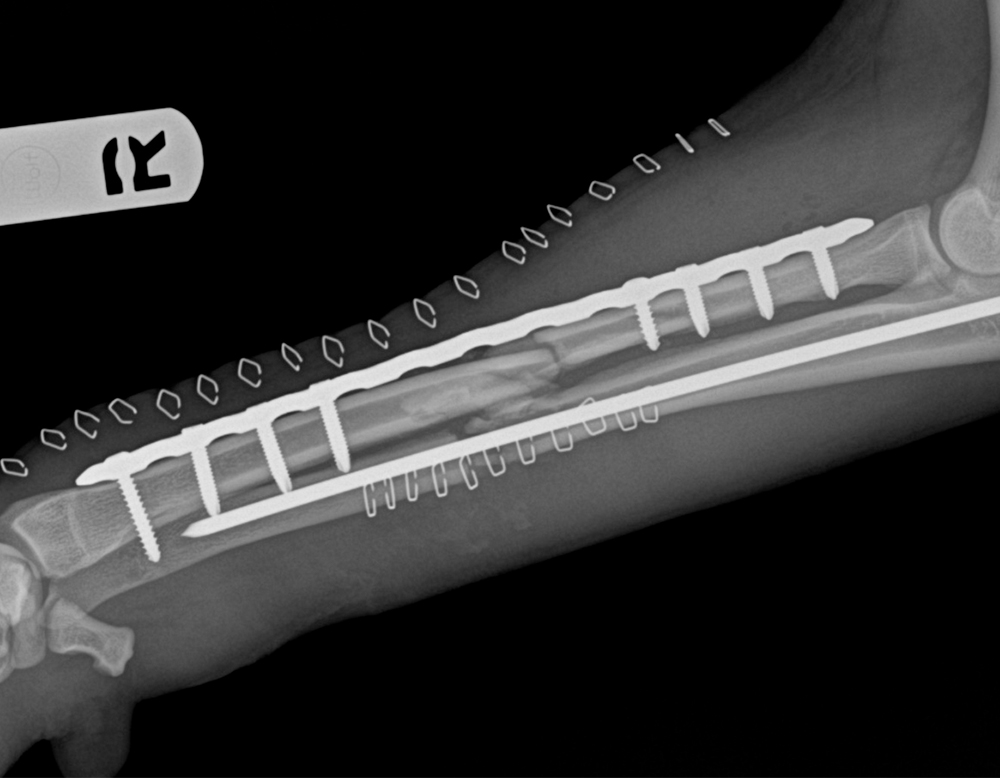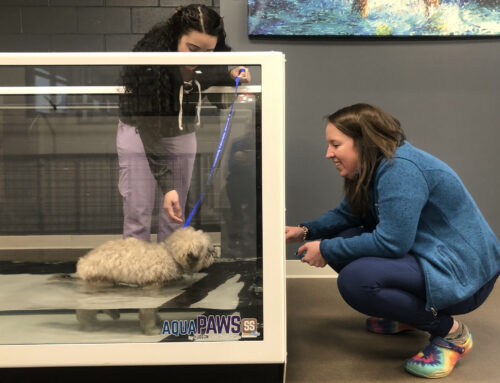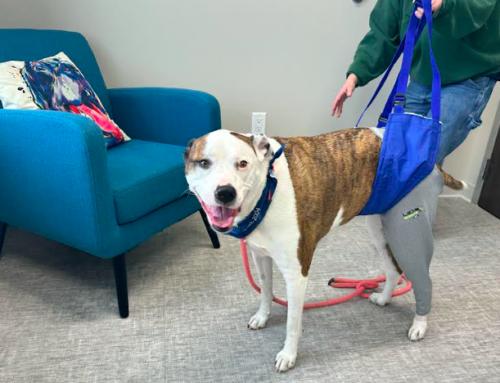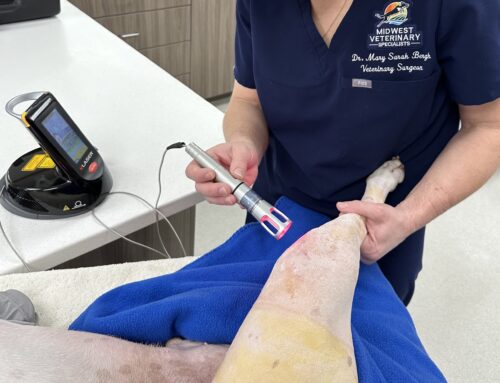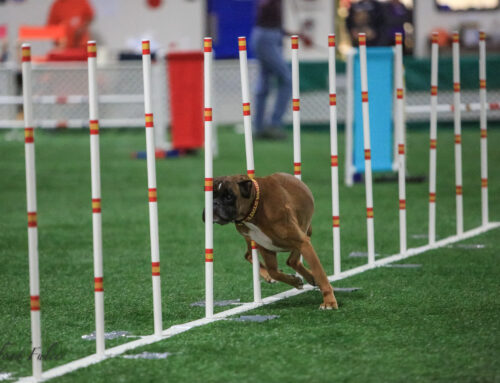Arthritis (i.e., osteoarthritis [OA]) is a degenerative joint condition that causes joint pain and decreased mobility for many pets, despite surgical treatment, or in cases where surgical procedures aren’t always indicated. Fortunately, there are many treatment options available to help improve an arthritic pet’s quality of life, and a multimodal treatment plan often leads to the best results. Our team at Midwest Veterinary Specialists want to provide information about these therapies to help you determine the best treatment options for your arthritic pet.
Nutritional management for arthritic pets
Excess weight places strain on arthritic joints, and fat tissue produces a constant, low-grade inflammation that exacerbates degeneration inside joints. If your arthritic pet is overweight, a weight loss program will be devised to help them safely lose the excess pounds. Another dietary aspect that may help arthritic pets includes omega-3 fatty acid supplementation. Omega-3 and omega-6 fatty acids are essential polyunsaturated fatty acids (PUFAs) that are required for numerous bodily functions. When arachidonic acid (AA), an omega-6 fatty acid, is metabolized, inflammatory chemicals are produced. Providing more omega-3 fatty acids, such as eicosapentaenoic acid (EPA) and docosahexaenoic acid (DHA), replaces AA in the cell, decreasing inflammatory mediator production.
Shock wave therapy for arthritic pets
Shock wave therapy involves delivering acoustic (i.e., sound) waves to promote natural healing inside a joint and its surrounding structures. The waves can travel to various tissue depths, targeting specific areas at different densities. As the waves are administered, a phenomenon known as a cavitation bubble occurs, which causes deviations in the cell surface. These deviations make the cell membrane more permeable, allowing the waves to stimulate regeneration. In addition, this process causes certain cells to be released that decrease inflammation and provide an analgesic effect. Treatments typically take about 5 to 10 minutes, and your pet may need multiple sessions, two to three weeks apart, before improvement is observed. At Midwest Veterinary Specialists, we have the most technologically advanced shockwave therapy on the market, PulseVet Propulse Shockwave therapy, which delivers strong pulses without the pain. It does not require sedation or anesthesia to apply!
Laser therapy for arthritic pets
Laser therapy uses light to therapeutically stimulate non-thermal reactions inside cells that result in beneficial outcomes. This is a noninvasive procedure that promotes cell regeneration and increases blood circulation. At Midwest Veterinary Specialists, we have a Class 4 K-Laser that is both safe and effective. Laser therapy has many benefits for arthritic pets including:
- Pain reduction
- Reduced inflammation inside the joint
- Reduced swelling
- Increased joint mobility and function
- Collagen production stimulation
Laser therapy treatments typically take about 10 to 20 minutes, and the frequency of the sessions depends on your pet’s condition.
Ultrasound therapy for arthritic pets
Therapeutic ultrasound produces sound waves by applying an electric current to a crystal inside the ultrasound probe, causing the crystal to vibrate at a specific frequency. Using a water soluble gel, the probe head is placed on the pet’s skin, causing the molecules in the waves’ path to vibrate at a microscopic level. This process increases blood circulation to the area, delivering healing cells and dispersing natural toxins. In addition, the ultrasound waves decrease swelling and promote healing. Sessions usually take 10 to 20 minutes, and most pets are treated two to three times a week until improvement is seen. Ongoing treatments may be recommended to keep your pet comfortable.
Hydrotherapy for arthritic pets
Hydrotherapy refers to using water therapeutically to aid or improve health. Water-based exercises can help rebuild muscle mass, promote cardiovascular output, and improve stamina, as well as improve range of motion in arthritic joints. For pets, hydrotherapy mostly involves swimming or walking on an underwater treadmill.
- Swimming — Swimming in a controlled pool setting provides a good cardiovascular workout, and works the core musculature. This exercise can help increase the calorie burn for overweight arthritic pets, making it easier for them to participate in physical activity. Swimming can also be beneficial in improving range of motion for conditions like elbow dysplasia.
- Underwater treadmill — When a pet walks on an underwater treadmill, the water provides support to alleviate pressure on their joints. This allows arthritic pets to exercise with less pain and discomfort as opposed to walking on land. An underwater treadmill provides better control over a pet’s exercise program than swimming. The water level and treadmill speed can be adjusted to tailor the exercise, depending on a pet’s physical condition and capability.
Land therapy for arthritic pets
Land-based rehabilitative exercises allow pets to regain their mobility in real-world conditions. Techniques such as stretching, controlled leash walking, and navigating ramps and agility courses are used to provide low-impact exercises that help build muscle strength and increase range of motion. A therapeutic program with land exercises can be tailored for any pet, based on their mobility and arthritis severity.
Pharmaceutical therapy for arthritic pets
Medications frequently are needed to manage arthritic pets. Common pharmaceuticals include:
- Cartilage support supplements — Supplements, such as glucosamine and chondroitin sulfate, may be prescribed to provide the building blocks necessary to repair damaged cartilage.
- Non steroidal anti-inflammatories (NSAIDs) — Many prescription NSAIDs (i.e., aspirin-like drugs) are available to decrease pain and inflammation in arthritic pets. These medications work by suppressing inflammation and pain mediators inside the joint.
- Pain relievers — Certain medications don’t have anti-inflammatory properties but work solely to reduce pain. These drugs may cause drowsiness.
- Monoclonal antibody therapy — A monoclonal antibody drug was approved by the U.S. Food and Drug Administration (FDA) in January 2022 to address arthritis pain in cats.
Orthobiologics
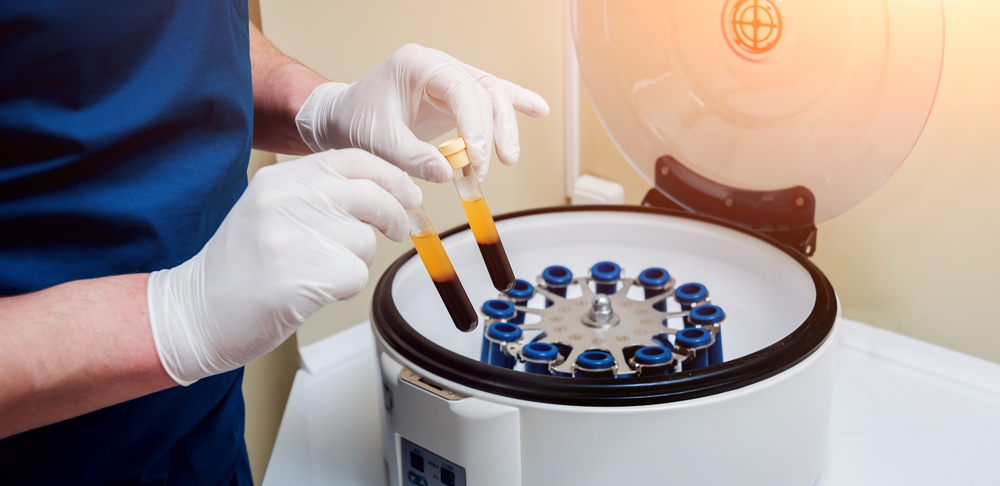
- Platelet rich plasma (PRP) — This therapy involves drawing blood from your pet, separating out the platelet and plasma portion, and injecting it into the joint. Doing so can promote healing and decrease pain in osteoarthritic joints.
- Stem cell therapy — There is some evidence that stem cells gathered from the bone or fat can be used to treat pain associated with arthritis.
Arthritis management typically involves a multimodal approach, involving medications, rehabilitation techniques, and adjunctive therapies. Midwest Veterinary Specialists has all of these modalities and we can devise the best strategy to treat osteoarthritis in your pet. Contact us today for a consultation!


